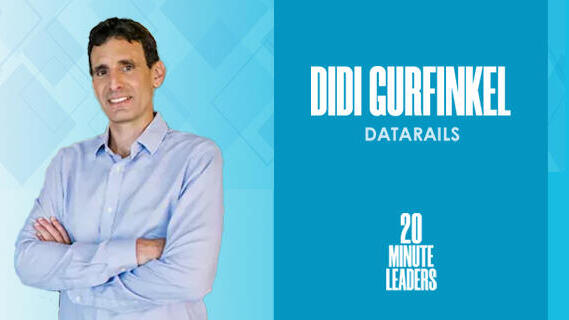
20-Minute Leaders
“Excel is like the canvas for financial people to create.”
Co-founder and CEO of DataRails Didi Gurfinkel shares that for financial people, spreadsheets are the canvas where they create and innovate.
While there are software solutions available to replace Excel, Didi Gurfinkel believed that finding a way to enhance Excel would be more successful. The co-founder and CEO of DataRails shares that for financial people, spreadsheets are the canvas where they create and innovate and they like the familiarity of Excel. So DataRails built technology that puts automation around Excel. Users still interact with the program they are familiar with and the models they’ve built, but it connects to a database of powerful tools. He says that it took some time to find the right product market fit for their technology, but once they pivoted to focusing on financial planning and analysis, the company really took off. Gurfinkel explains that automating consolidation means data can be analyzed much more often, which allows CFOs to provide even more value to their CEOs and boards.
Click Here For More 20MinuteLeaders
Taking the humans who are used to making decisions based on various tool sets and how we leverage technology to change that decision-making process: I think it’s just fascinating. You're at the forefront of that with one of Israel's leading FinTech and data startups, DataRails.
If you look at the different departments or verticals in an organization, you will see that most of the departments—sales, marketing, HR—are managed in cloud-based applications. You won't find a VP sales of a medium-sized company that runs their sales in Excel or Monday. They have a specific SaaS solution for each vertical.
But if you go to the financial department, you will see a lot of manual work based on Excel. This is not because there aren't any available solutions in the market. Still, 85, 90% of the companies use Excel-based processes to run their financials. It's the key to understand what we do in DataRails, the product market fit that we have, and to understand how it is possible to penetrate this market. I believe it should start with understanding the role of a spreadsheet or Excel in the life of a finance person.
Before this, I worked in Cisco. I was a GM, and I was so surprised to see the amount of processes and how Cisco relies on Excel. Not because of a lack of a budget or manpower; it's about the magic or the advantage that Excel brings that no other solution actually provides. For financial people, Excel is kind of even an operating system. It's like the canvas for them to create, to take ideas, to take models that they try to implement.
You're saying, "We have to give respect to spreadsheets or Excel as an operating system. It's not a feature to be replaced. It's a canvas of innovation and opportunity where every team can now create their own sets of tools." That's why it's a different type of beast, right?
Exactly. This is why in DataRails, the product market fit that we found is that we do not try to take the CFO and the financial people out of Excel. We keep the flexibility and the familiarity, keep Excel as the front end and as the tool that they interact with, but build a full automation around Excel. This automation actually generates a database that is injected into the Excel. They keep seeing, using, smelling, feeling Excel, but this Excel sits on top of a database. They get the full automation, powerful analytics, all the drill-down capabilities, slice and dice that in Excel is very complex and tedious.
Because it's a database and cloud-based, we also provide collaboration with a web-based dashboard and visualization. But the core is Excel, their existing Excel. We do not replace and start to build your report from scratch. We use the same report, the same models. We keep these assets, but we add the automation and the database behind this.
We found a different angle to the market that actually exploded. With this product market fit, in two years we got to a number that broke any benchmark in the market in terms of growth, number of customers, revenue. There is no one in this era that's even close to these numbers.
Take me back to those five years of searching for that product market fit. I think that the traditional person may say, "Excel is old news. Let's build a whole new set of tools for them." But you're saying that's actually not the right way of thinking about this.
When we started, we knew for sure that Excel is not a temporary solution and Excel is here to stay and the one billion Excel users will not go anywhere. This is an assumption. I met with many VCs that said, "Excel belongs to the past. Don't talk to me about Excel."
I believed differently. We actually had the feeling that we sit on top of oil: a billion users of Excel with many problems and challenges. We tried to find a way to build a business, to find a specific problem to solve. We started by building the technology. We built a platform that knows how to take semi-structured data from Excel and transform it into a structured database. This is a super interesting technology because no one actually invested any manpower and brainpower in this area.
It's a huge technological feat that many amazing researchers are working on. Right?
Exactly. We succeeded, and we have three patents registered on this technology. With this technology, at the beginning, we tried to sell it to large organizations that rely on Excel: banks, insurance companies, financial institutions. The pitch or the value was, "Control your data. Take all your semi-structured data and organize it in a centralized cloud-based database.” It wasn't focused on a vertical. Then we played around different use cases. We tried to sell it to VCs to manage their portfolio. Then from the customer base, we had like 10, 15 customers that half of them actually used it for consolidation.
Then we understood that the consolidation for financial people is a challenge, it's time-consuming, and it's the reason for all their manual processes. We didn't change the platform at all; we just shifted the go-to market to the FP&A vertical and then we started with the same platform. Once we did this pivot and we started to sell this product to these people, the product market fit hit like an explosion.
What are some questions that DataRails helps financial planners answer in their day to day?
The questions are very simple and repetitive questions. What happened last period? What happened that is unique to this month? How the facts that I just realized for the last period affect my next period, next quarter, next year. This is what the financial people need to answer month over month.
If we're looking back at the way that Excel was before and the enrichments that DataRails provide, how do you describe the before and after?
Before, this process of collecting the data, preparing the data and getting the results, was a process of a few weeks. Usually, they run it once in a quarter. Then, by the end of the quarter, it takes almost a month to get to the results.
Once you automate this consolidation process, you can do it even on a daily basis. You don't need to wait, so you have this data available to analyze. So every week, every day, you can analyze the data and compare it to the previous data, and it sits on top of your insights in a continuous way. It's a huge change in the value that the CFO can actually provide to the CEO and the board.
Is DataRails a FinTech company or a data company?
It's not a FinTech. It is a software solution company.
It sounds to me that the technology behind it has virtues beyond a tool for FP&A. I can think of many different use cases where this would be relevant.
A hundred percent. First, there is a term called "xP&A,” which is, actually, that every manager in the organization needs to run planning. This tool can help you to run planning for every department. The focus on the office of the CFO is important. First, because you need to focus for go-to-market. Second, the product is getting more and more financed. On top of the platform, the data, and the pure data consolidation capabilities, we're adding more and more financial capabilities that make it an FP&A monster, specific to finance.
Michael Matias, Forbes 30 Under 30, is the author of Age is Only an Int: Lessons I Learned as a Young Entrepreneur. He studies Artificial Intelligence at Stanford University, is a Venture Partner at J-Ventures and was an engineer at Hippo Insurance. Matias previously served as an officer in the 8200 unit. 20MinuteLeaders is a tech entrepreneurship interview series featuring one-on-one interviews with fascinating founders, innovators and thought leaders sharing their journeys and experiences.
Contributing editors: Michael Matias, Megan Ryan
